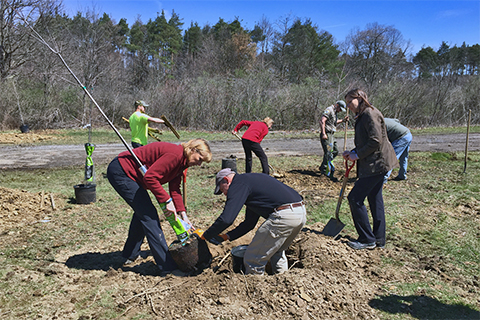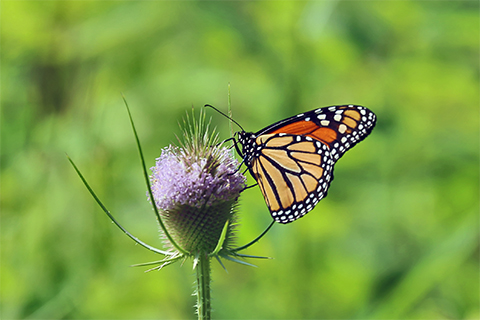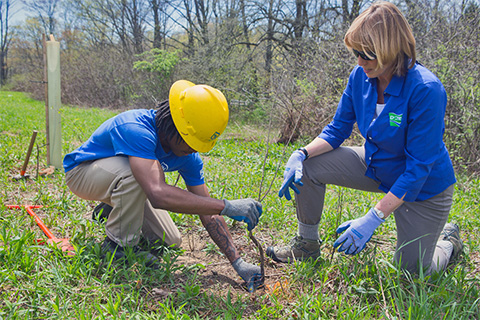On the eve of Earth Day 2020, I’m thinking about trees and the resilience and steadfastness they represent, and what the planet will look like on the 100th anniversary of Earth Day in 2070.
Trees are indelibly connected to Earth Day in my brain for all the expected reasons -- they clean water; absorb and hold carbon; shelter and feed birds and other wildlife; cool streams for fish and aquatic life; and are a beautiful symbol off all things natural.
There is no such thing as an environmental panacea, but trees come as close as anything on Earth.
Some trees stand out in my life and have been a constant and a comfort in times of turmoil and tragedy.
I think one reason so many people are taking comfort in nature and the outdoors during the COVID-19 pandemic is for a comforting connection with something greater and longer termed.
My Red Oak Tree

Perhaps the most special tree in my life is the red oak my Dad planted on our property in Fishing Creek Valley near the time I was born.
I don’t remember its planting, of course, but my Dad called it my tree.
As a child, a rebellious teen, a young adult, and then into maturity, I always looked at that tree fondly.
When Dad passed away, I took some comfort in looking at the large stately tree he planted for me.
Much later, when my Mom sold her house to move closer to us, it was the largest tree on the property. I hope it still stands.
Perhaps this early experience is what caused me to be a tree planter.
I make a point to always plant trees around Earth Day as part of a volunteer effort, or on my own.
The Tragedy of the Wye Oak
I remember tree tragedies in my life too. One was when the famous Wye Oak on the eastern shore of Maryland was toppled by a windstorm.
The Wye Oak was so magnificent that it was considered a state park!
Not only was it a stunningly impressive tree, it was long-recognized as the oldest tree in the nation.
It was around in the 1500s; and was along the “Choptank Trail” traversed by local native peoples and later, the early settlers.
The Choptank Trail eventually became a road that connected Oxford to Philadelphia.
Surely Harriet Tubman used this route on occasion as she led slaves to freedom on the Underground Railroad from farther down the eastern shore to the Philadelphia area.
My parents were so inspired by the Wye Oak that we would divert off busy Route 50 to stop by and take a stretch break on long drives to Chincoteague.
We’d marvel at its size and enjoy its generous shade. I continued this tradition on my own, on many trips for work and play over the decades.
I think what was so magnetic about that tree to me, and my family, was the timeless quality it had.
That tree had seen human strife from the American Indians, to slaves seeking freedom, to generations of local farmers working the land.
It withstood storms and drought, pests, road widenings, and human ambitions.
On June 6, 2002, the mighty Wye Oak succumbed to a thunderstorm.
At the time of its demise, it measured 31 feet 8 inches in circumference.
The main trunk of the tree weighed 61,000 pounds and it was thought to be 460 years old. How could something so PERMANENT be gone?
The Fragility of Nature and Life

The tragedy of the COVID-19 pandemic reminds me how apparently fragile our normal routines can be.
Life and work were humming along for most people. How can something that we all took for granted be changed so dramatically in just a few weeks?
Just as the COVID crisis was shaping up in Pennsylvania, I read an article about the Wye Oak that really made me happy.
There are Wye Oak clone seedlings being grown in various places, having been nurtured by the Maryland Department of Natural Resources and stewarded by seedling owners.
It’s a good reminder that the Earth, and all its inhabitants can be resilient, if given a chance.
There will be a new normal after COVID-19. But on the eve of Earth Day 50, can humans carve a path forward that will avoid human and ecological catastrophe?
Will people act decisively and continue steady reduction in carbon emissions over the next several decades to combat climate change?
Without decisive action, we face an insidious and constantly growing threat to the future of humans and the web of natural life we depend on.
Will our successors be able to celebrate or lament on Earth Day 2070? What will be said about the actions taken on 2020, 2025, 2030, and their impact on humans and the Earth in 2070?
Decisive actions and commitment today will determine what the Earth Day 100 in 2070 will look like.
Human and Natural Resiliency

Coming out of the COVID-19 crisis, people everywhere will be more aware of how our fates are interconnected.
As some businesses collapse and others are built, will they be more sustainable? Will a new awareness about human fragility translate to environmental actions?
In addition to removing carbon from the atmosphere, will people turn to the resiliency that nature offers every day?
Cloning technology allowed the Wye Oak to be genetically reproduced. After all, those genes had resisted myriad pests over the centuries.
The technology exists today to massively reduce and eventually eliminate carbon in the atmosphere.
If we can rebuild our economy after the COVID pandemic, what would a robust sustainable economy look like?
Certainly, the earth’s natural systems such as clean water, forested landscapes, and clean air would be paramount.
If we can rapidly adjust our lifestyle to evade contracting COVID-19, what permanent adjustments can we make to reduce our carbon footprint?
Will we increase habitat connectivity, streamside buffers, and sustainable communities?
We know we’re resilient. We are proving it every day since the pandemic hit.
We are helping each other, making major adjustments in our work and home lives.
We can use Earth Day 2020 to resolve to make Earth Day 2070 a celebration of human and natural resiliency.
Let’s have the Earth Day 2070 celebrants tell the story about 2020 as the turning point, just as we today are telling the story of the first Earth Day in 1970.
Note: The public can join DCNR Secretary Dunn at a virtual Climate Commitment Signing event at 1:00 P.M. at her alma mater Shippensburg University; and at a free online screening of the documentary Penn’s Woods: Cradle of Conservation and panel discussion, sponsored by WITF and the Pennsylvania Parks and Forests Foundation, at 7:00 P.M. on Earth Day, Wednesday, April 22.